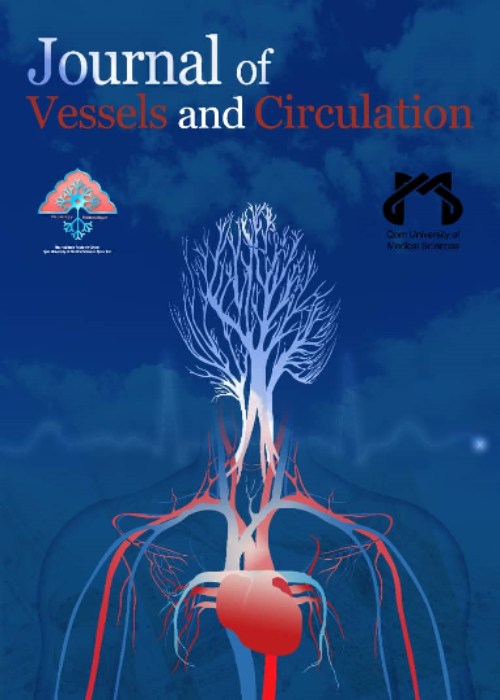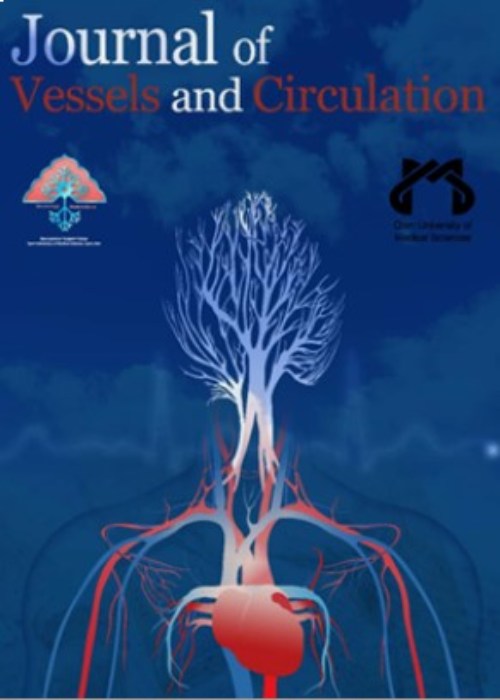فهرست مطالب

Journal of Vessels and Circulation
Volume:3 Issue: 3, Summer 2022
- تاریخ انتشار: 1402/08/02
- تعداد عناوین: 6
-
-
Pages 107-116Background and Aim
Upper extremity deep vein thrombosis (UEDVT) accounts for 1% to 4% of deep vein thrombosis (DVT) cases and can be associated with complications and mortality. This study aims to review the upper extremity DVT diagnosis methods and evaluate the sensitivity and specificity of commonly available diagnostic tests for upper extremity DVT that can be used to provide a combined diagnosis strategy.
Materials and MethodsArticles in this study, national databases, including Magiran, SID, and IranMedex, as well as international databases, including PubMed, Google Scholar, Scopus, and ISI databases, were searched for related books and articles. Keywords, including upper extremity deep vein thrombosis, thrombolysis, diagnosis, upper extremity deep vein thrombosis, thrombolysis, and diagnosis were searched and finally, 50 articles were reviewed.
ResultsThe accuracy of the D-dimer test for the diagnosis of UEDVT was evaluated in two studies. The sensitivity and specificity of D-dimer with a cut-off value of 500 micrograms per liter are 100% (95% confidence interval [CI], 78% to 100%), 14% (95% CI, 4% to 29%), 92% (95% CI), 73% to 99%), and 60% (95% CI, 52% to 67%). Duplex ultrasound has become the first line of diagnosis. The combined sensitivity and specificity of different ultrasound methods were, respectively, 84% (95% CI, 72% to 97%) and 94% (95% CI, 86% to 100%) for non-compression doppler ultrasound, 97% (95% CI, 90 to 100%) and 96% (95% CI, 87 to 100%) for compression ultrasound, and 91% (95% CI, 85 to 97%) and 93% (95% CI, 80 to 100%) for compression doppler ultrasound.
ConclusionUEDVT is an increasing clinical problem and requires accurate and rapid diagnosis to prevent complications. Clinical suspicion should be confirmed by diagnostic imaging methods, such as duplex ultrasound, computed tomography (CT) scan, or magnetic resonance imaging (MRI). A diagnostic strategy based on sequential evaluation of clinical factors and D-dimer test can avoid imaging in about a quarter of patients. Ultrasound is widely used as a first-line imaging test and, if inconclusive, may be followed by a second ultrasound, CT venography, or magnetic resonance imaging (MRI).
Keywords: Upper extremity deep vein thrombosis, Diagnosis, Diagnostic imaging, Ultrasonography, Epidemiology, Mechanical thrombolysis -
Pages 117-124Background and Aim
This article is an attempt to summarize the most updated information on heart rate variability (HRV) in ischemic stroke and to contribute to the clinical translation of this field. A wide range of pathologies, including vascular diseases (with stroke as a hallmark), are related to HRV. The parameters of this phenomenon can open a window to improve clinical approaches. The interval between two consecutive heartbeats is changed by the autonomic nervous system and these changes are called heart rate variability or HRV. Higher range and complexity of HRV fluctuations indicate better and more effective vascular and autonomic self-regulation and repair capacities.
Materials and MethodsThe keywords including “heart rate variability”, stroke, and “cerebrovascular event” were used and PubMed, Scopus, SID, and Google Scholar databases were searched. Reference books on neurology and clinical neurosciences were also used. Researchers checked the relevance of the documents and excluded irrelevant findings.
ResultsSeveral book chapters, together with 50 related reports and journal articles were identified, all of which were studied. The important and acceptable concept line of this field was extracted and reported here.
ConclusionHRV fluctuations decrease after ischemic stroke, therefore, they show autonomic impairments leading to an increase in sympathetic activity and a decrease in parasympathetic activity in the acute stage of stroke. These changes may persist and be associated with an increased risk of subsequent mortality. In patients with acute ischemic stroke, HRV could be a biomarker with prognostic value and may differentiate favorable and unfavorable outcomes of treatments. Moreover, HRV parameters have a predictive value for the occurrence of ischemic stroke, especially in normal people or patients with significant vascular risks. Overall, HRV recording can be valuable not as an independent tool but as a complement to remove barriers and gaps in the clinical management of stroke; and perform the task of objectifying the patients’ vascular conditions and alterations. Recording these parameters is practical, inexpensive, portable, and therefore, easily implemented in various clinical situations.
Keywords: Stroke, Nervous system, Heart rate determination, Neurophysiology, Ischemic stroke -
Pages 125-132Background and Aim
The present study was conducted to investigate the relationship between spiritual health, positive thinking, type D personality, and health-promoting lifestyle with death anxiety in heart failure patients.
Materials and MethodsThis research was analytical-cross-sectional conducted in 2022. The statistical population included all heart failure patients in Yazd city, Iran, in 2021. A sample of 200 people with heart failure disease was selected using the convenience sampling method. The data collection tools in this research included Poltzen-Wallis’s (1982) spiritual health questionnaire, Ingram and Wisnicki’s positive thinking questionnaire, personality type D questionnaire, Walker’s health-promoting lifestyle questionnaire, and Templer’s death anxiety questionnaire. The data were examined and analyzed using correlation and regression analysis. SPSS software, version 26 was used to analyze the data.
ResultsThe results showed that spiritual health, positive thinking, type D personality, and health-enhancing lifestyle reduce death anxiety in heart failure patients and the relationship between the variables is positive and significant.
ConclusionThe results indicate that the higher the level of spiritual health, positive thinking, D personality type, and health-enhancing lifestyle among heart failure patients, the less death anxiety, and the higher the mental health of the patients, the better their quality of life.
Keywords: Spiritual therapies, Optimism, Type D personality, Anxiety, Heart failure -
Pages 133-138Background and Aim
Carotid intima-media thickness (CIMT) is vital to investigate vascular atherosclerosis. Studies have provided conflicting information regarding the factors affecting this thickness. This study aims to determine CIMT in adults and investigate its relationship with background variables, and metabolic and nutritional factors.
Materials and MethodsThis cross-sectional study was conducted on the adult population of Mashhad City, Iran, and in the cohort center of Mashhad University of Medical Sciences during 2018-2019. At the beginning of the study, a complete history was taken and general examinations were performed. For all subjects, a B-mode ultrasound was performed by a radiologist in the neck region to evaluate the carotid arteries. Also, anthropometric characteristics, including height, weight, and body mass index, and metabolic factors, including blood sugar, blood pressure, cholesterol level, triglyceride level, and nutritional factors, including daily calorie consumption were calculated.
ResultsA total of 431 people with an mean age of 43.41±6.59 years were included in the study, 190 cases (44.1%) were men and 241 cases (55.9%) were women. The median thickness of the left carotid artery (0.63, 0.50) was 0.55 mm, and the median thickness of the right carotid artery (0.49, 0.61) was 0.54 mm (P=0.003). Also, the mean intima-media thickness (IMT) of the right and left carotid arteries was significantly higher in males than in females (P<0.05). Correlation of different quantitative data with IMT of both carotid arteries showed that all quantitative data except pulse rate (P<0.05) and energy (P<0.05) had a significant positive correlation with IMT of both right and left carotid arteries which were weak to moderate. Age and weight had a direct and significant relationship with the right and left CIMT (P<0.05). In addition, the male gender was associated with greater thickness of the left carotid artery (P<0.05).
ConclusionThe results of our study indicated that what is almost certainly related to CIMT is age and weight, which increases with the increase of both CIMT. More studies are needed to confirm these things
Keywords: Carotid intima-media thickness, Nutritional, metabolic diseases, Nutritional status -
Pages 139-146Background and Aim
Bacterial infections can stimulate immune responses, directly or indirectly, mainly by interacting with inflammatory and immune pathways, which negatively affect cardiovascular risk factors. The severity of Helicobacter pylori infection can be an essential determinant of its atherogenic potential. Carotid intima-media thickness (CIMT) is a quantitative ultrasound-based parameter that may predict a subclinical atherosclerotic disease in an individual. Considering the previous studies and lack of accurate known etiology for atherosclerosis and the high prevalence of this infection in growing communities, particularly in Iran, this study was conducted to investigate the relationship between H. pylori infection and CIMT. We compared IMT in infected and non-infected patients with H. pylori in the present study.
Materials and MethodsThis descriptive study was performed on 68 patients undergoing endoscopy in the gastrointestinal ward of Ali Ibn Abi Talib Hospital in Rafsanjan City, Iran, from 2020 to 2021. The sampling method was convenience sampling. After selecting eligible patients, a biopsy specimen was taken from the antrum and gastric mucosa during endoscopy. Based on the rapid urease test results, patients were divided into two equal groups (n=34) infected and non-infected with H. pylori. Patients’ demographic information and serum C-reactive protein (CPR) level were extracted from the patients’ files and entered into a pre-designed checklist. Then, the CIMT was measured by a radiologist using a GE Voluson E6 color Doppler ultrasound machine. Data were collected and analyzed in SPSS software, version 22. A significance level of 5% was considered.
ResultsIn infected and non-infected patients with H. pylori, no significant difference was observed between the mean age (P=0.215), body mass index (P=0.074), gender (P=1), smoking (P=0.779) and family history (P=0.801). However, the mean level of CPR (P=0.007) and CIMT (P=0.023) in patients infected with H. pylori were significantly different from those not infected with H. pylori and patients infected with H. pylori showed significantly higher values of CRP and CIMT.
ConclusionThe results of this study showed that patients infected with H. pylori are more prone to increased CIMT than non-infected individuals with H. pylori, which may be associated with increased CRP as an inflammatory marker in the inflammatory pathway.
Keywords: Atherosclerosis, Helicobacter pylori, Carotid arteries, Carotid intima-media thickness -
Pages 147-158Background and Aim
Methamphetamine abuse causes tachycardia, tachypnea (hyperventilation), high blood pressure, rupture of heart vessels, and an increase of fibrotic tissue in the human heart. This study aimed to investigate the histopathological effects of aerobic training and vitamin E consumption on the heart following the consumption of methamphetamine in male rats.
Materials and MethodsIn this research, 54 adult rats weighing 200-210 g were divided into 6 groups, saline, addicted (sham), addicted+oral paraffin (AP), addicted+supplement (AS), addicted+aerobic training (AAT), addicted+aerobic training+supplement (AATS). After 23 days of methamphetamine injection, moderate-intensity aerobic training was performed for 6 weeks and 150 mg/kg of vitamin E was administered by gastric gavage. After this period, the rats were dissected and their hearts were removed. The data were analyzed using one-way ANOVA methods at P<0.05.
ResultsThe morphological investigation showed a difference between the two groups of sham and AP with the saline, AS, AAT, and AATS in the space between the endocardium, congestion, and vascular rupture. There was a difference in the hypertrophy of muscle fibers between the sham and AP with the saline, AS, AAT, and AATS in the morphometric investigation.
ConclusionIt can be said that methamphetamine causes pathological hypertrophy of cardiomyocytes and destruction and rupture of blood vessels, and aerobic training along with vitamin E consumption causes physiological cardiac hypertrophy. Regarding the effect of vitamin E alone on the type of cardiac hypertrophy and vascular changes, further studies are needed.
Keywords: Methamphetamine, Exercise, Vitamin E, Hypertrophy, Aerobic training


